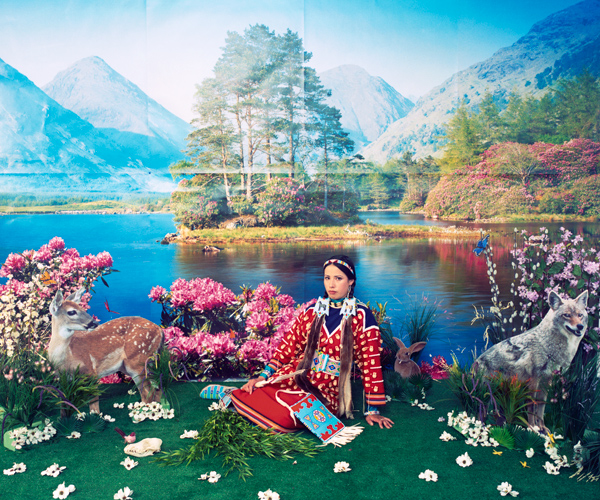Perhaps the best way to think about “Unsettled,” the ambitious fall exhibition at the Nevada Museum of Art, is from a planetary perspective. As a complement, a separate project concurrently on view suggests and reinforces that viewpoint. A one-to-one scale model of a small satellite tethering a large spherical Mylar balloon, Orbital Reflector (2017) by Trevor Paglen, is the first object that comes into view on entering the museum, and the last before leaving, bracketing the exhibit. The actual satellite—a joint project with the museum—will be sent into low earth orbit for several weeks in 2018 to deploy a slightly larger, diamond-shaped balloon.
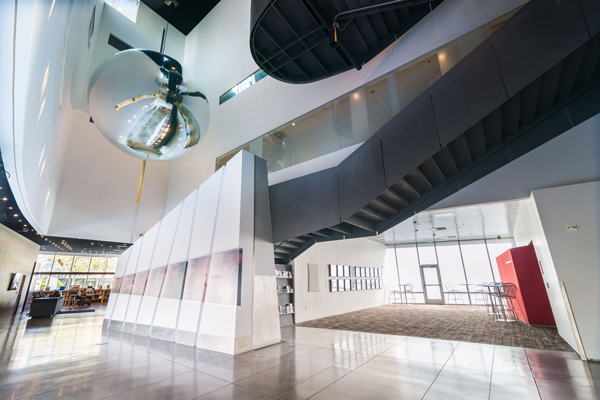
Prototype for Trevor Paglen, Orbital Reflector, co-produced and presented by the Nevada Museum of Art, courtesy of Nevada Museum of Art.
The project orients away from the parochialism of regions or even nations, to a planetary, a solar-system-and-beyond perspective on our globe. In orbit, the reflector will be visible to the naked eye, and can be tracked with an app. The ensemble that hangs in the museum’s four-story entry hall is a kind of sentinel and harbinger of what is to come. Though it ostensibly comments on Earth orbit as the staging ground for satellites or a junk yard of detritus, Orbital Reflector demarcates human migration, not just as witnessed in the planet’s past, but what seems, with increasing urgency, to be in our very near future, in a trajectory off the planet, the boundary of what may be the next great human migration (that is, after people living in the hottest parts of the planet begin the next migration, fleeing the effects of climate change).
But dreams of escaping a planet increasingly hostile due to the machinations of capital and carbon run amok, achievable or not (whether on a small scale for a select few or on a mass basis), are fundamentally unequal. The billions of the world’s poor who are now suffering the early effects of climate change will never, one expects, be in a position to make a new start in a space colony (if that ever happens, for anyone). As a reminder of our place on the planet or in the stars, Orbital Reflector begins to feel like an ominous gesture.
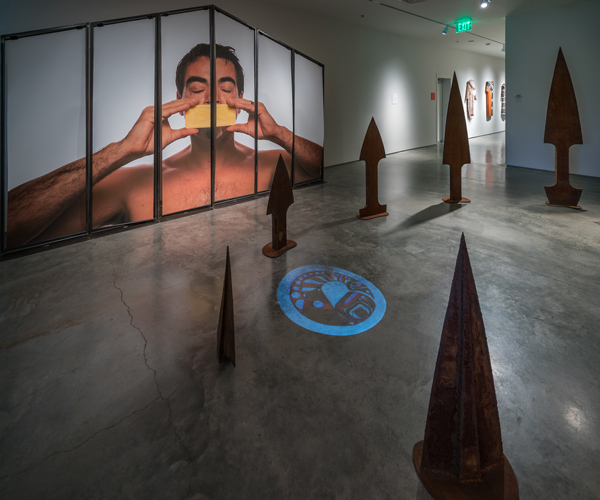
“Unsettled” installation view, courtesy Nevada Museum of Art
The larger exhibit, “Unsettled,” orients to human migration on the terrestrial sphere, focusing geographically on the last parts of the globe to be infiltrated by Homo sapiens in migrations out of Asia and into the Americas and parts of the Pacific. As such, it is a major articulation of the concept of the Greater West that the museum and its research institute, the Center for Art + Environment, have theorized as a focus of new research: a vast “super-region” stretching from Alaska to Tierra del Fuego along the western edge of the Americas, but which also includes Australia, New Zealand, New Guinea and countless Pacific Islands. Its geography is marked by large arid regions rich in natural resources. Oh… and it was populated with indigenous communities long before the Europeans came knocking.
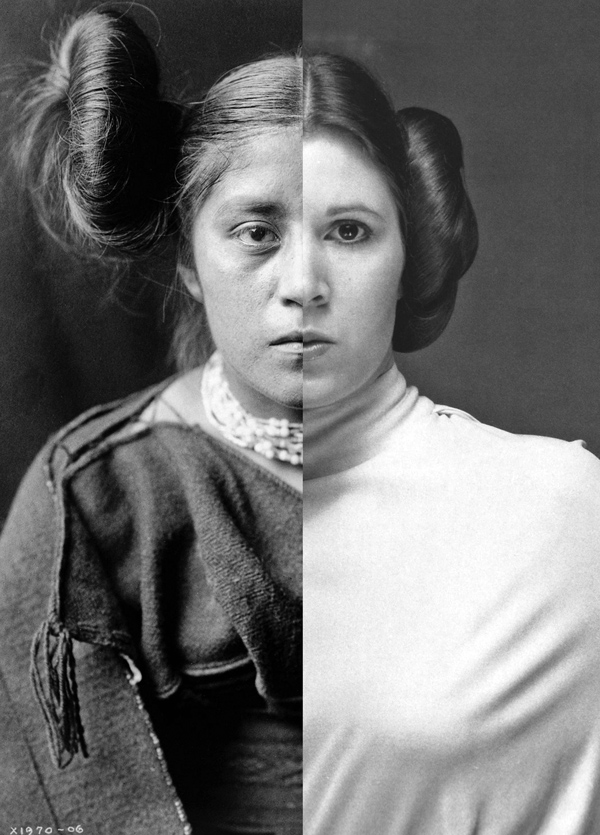
Nicholas Galanin, Things are looking Native, Native’s looking Whiter, 2012, Anchorage Museum Collection.
The exhibition is variously successful at addressing this overly broad theoretical focus—it never quite crystallizes into a single thesis. That big idea of the Greater West gets broken into various subsections within the exhibition, elaborating on the many manifestations of what it means to be unsettled. Art works illuminate the Greater West as a place of instability caused by tectonics as well as the clashing of cultures and contests over resources—giving rise, curator JoAnne Northrup writes in her essay, to novel forms of expression; and additionally characterized by vast open spaces that inspire feelings of the sublime.
Few pieces in the exhibit convey sublimity as successfully as Agnes Pelton’s desert paintings, Winter (1933) and Idyll (ca. 1952). These two exquisite, poetic images suggest a kind of mysticism paired with attentive observation of the desert’s open spaces, and their blooming shapes originate with the effects of light in the desert.
Works of art by various artists of European and indigenous heritage give voice to expectedly varied points of view on the clashing of cultures.
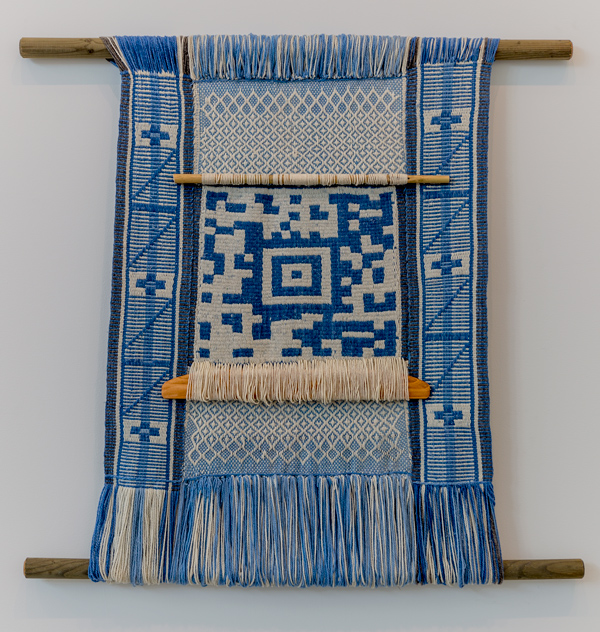
Bert, Guillermo, Mapuche Portal #1
Courtesy of the artist
Photograph by Ronald Dunlap
Especially poignant are two weavings by Chilean-born Los Angeles–based Guillermo Bert, who has embedded information-rich QR codes into traditional weavings. Scanning the large QR codes in Mapuche Portal #1 (2014) and Zapotec Poet (2015) activates additional content related to the works and their facture, and to the indigenous groups they were made by. These works address a number of salient issues, starting with the decimation that conquest brought to indigenous groups throughout the Western Hemisphere, and the disappearance of peoples, languages, technologies. The traditional weaving techniques result in objects that are supremely beautiful, and Bert’s conceptual schema very deftly intertwines idea and object.

Nicholas Galanin, Your Inane Perspective: Haa AanÍ Haa Kusteeyíx̱ (Our Land is our Life)
Anchorage Museum
Collection.
Nicholas Galanin’s work also points to the effects of conquest and the disappearance of culture; his work brings the question of cultural invisibility out of some distant past that we no longer control firmly into the present, and confronts it in its contemporary manifestations. His photograph Your Inane Perspective: Haa Aaní Haa Kusteeyíx Sitee (Our Land is Our Life), 2015, depicts a large road sign stating, “No Name Creek,” along a highway in Sitka, Alaska, where the road crosses a stream. Seated just below the large sign is a smaller one that, barely a tenth the size, announces the indigenous name for the stream: “Watlachéix’ k’i Héen.”
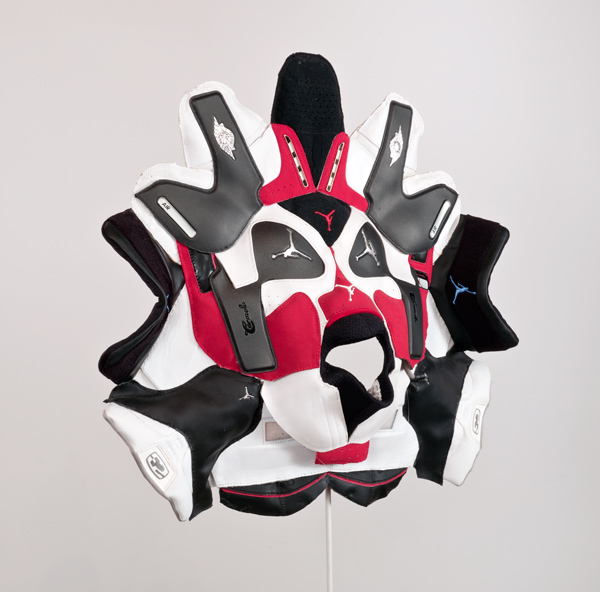
Brian Jungen, Prototype for New Understanding #23, courtesy of Debra and Dennis Scholl
Upending the colonization of culture and the use of images and symbols of Native Americans (think of sports teams with mascots and names like the Indians or the Braves), Brian Jungen’s works here subvert retail sporting goods, turning them into objects that look like Native American symbols. In Prototype for New Understanding #23 (2005), he literally cuts apart Nike Air Jordans and refashions them into a ceremonial mask. With 1960, 1970, and 1980 (all 2007), he turns golf bags into totems.
Regina José Galindo, whose uncompromising performances have repeatedly confronted the abuses of power against indigenous people, political dissidents and women in her own Guatemala, appears here in a series of still images and a video of her 2015 performance Desierto in Santiago, Chile. Desierto was made in protest of the collusion between the pine-timber industry and the Chilean government, highlighting the devastation of Chile’s pine forests and the violence inflicted on the environment and Chile’s Mapuche people.
Works like these that carry the power of many stories of indigenous communities, and articulate resistance to ongoing forms of cultural imperialism and economic devastation, are juxtaposed with works that demonstrate other facets of the museum’s framework of the Greater West. Many of these works are powerful in their own right; but, at times, reconciling how they interact, or what kind of conversation they carry on with each other can be a bit of a sticking point.

Chris Burden, All the Submarines of the United States of America (1987)
Chris Burden’s All the Submarines of the United States of America (1987) is an example of connecting the dots successfully. A powerful evocation of the U.S. military’s capacity, though it was made while the U.S. was still engaged in a cold war with the Soviet Union, it seems timelier than ever (in a turn that would have been difficult to foresee), given the U.S. President’s war of words with Kim Jong-un. Submarines is meant to elaborate on the “Shifting Ground” of the Greater West, which here extends beyond the region’s tectonic instability to include the awesome power we have exerted on the environment and society through our own inventions.

Don English, Miss Atomic Bomb, 1957
Submarines is paired conceptually with Bruce Conner’s CROSSROADS (1976), the film of the U.S. detonating an atomic bomb on Bikini Atoll, and a number of other works that address nuclear weapons and missile ranges, including Ed Ruscha’s Atomic Princess (1990). This theme is explicitly brought around to the impact on indigenous peoples in The End (1983), a painting of nuclear destruction visited on a landscape resembling the Nevada Test Site by Western Shoshone/Washoe artist Jack Malotte.
LA artist Ed Ruscha, quintessentially cool and laconic, punctuates the exhibition’s major sections in a kind of running commentary, and he is credited as a consulting curator. Ruscha’s Chocolate Room (1970), which he first created for the American pavilion of the Venice Biennale, is one of the most magnificent works in the show. Profound for its olfactory assault, its pungent, sweet smell of chocolate is enveloping. It’s tempting to call it a commentary on the colonization of the Americas, but nothing in Ruscha’s discussion of its origin suggests a political discourse embedded in the materials, i.e., chocolate’s origins in Mesoamerica and its quick absorption as a commodity and production as a luxury good in Europe.

Da-ka-xeen Mehner, Da-ka-xeen, the Thlinget Artist, 2005, from the series, “Reinterpretation,” ©Da-ka-xeen Mehner
But the real power is in works like Finding My Song (2012), an installation by Da-ka-xeen Mehner, which alludes to the experiences of his grandmother, when as a girl her mouth was washed with soap for daring to speak her native language, Tlingit. Along these same lines, Mehner’s “Reinterpretation” series (2005–07), photographs that subvert ethnographic conventions by substituting his own image in representations of Tlingit culture from 1906 studio portraits, and Wendy Red Star’s “Four Seasons” series (2006), reclaim authorship for the indigenous.
That the exhibition addresses the perspective of indigenous peoples, including so many examples of art that function as resistance, is one of its strengths. At times, the exhibition’s conceptual framework does not adequately address the space between cultures, or the mechanisms of cultural exchange and dynamics of power that structure such exchanges, but works by artists like Bert, Galindo, Galanin, Mehner, Red Star and others speak for themselves.
“Unsettled” runs through January 21, 2018
Nevada Museum of Art

